|
Germany number one
During
first half of the 20th century Germany was the absolute number one when it came to cameras, lenses and other photographic
equipment. Not even the severe demolition of production facilities and infra
structure during WW2 kept the German photo industry from fast regaining its
former market leadership.
The leading actors
At the end
of the 50's there were numerous German manufacturers of cameras, Adox, Agfa, Edixa, Leitz Wetzlar (Leica), Rollei, Voigtländer and Zeiss
Ikon, just to mention some of the better known.
Agfa,
Leitz and Voigtländer made their own lenses for their own cameras.
Zeiss-Ikon also made lenses for two camera manufacturers with whom they were not in direct competition, Rollei Werke (Francke & Heideke) in Braunsweig and Swedish Hasselblad. Schneider-Kreuznach,
Enna, Isco and Rodenstock had no camera production but designed lenses for a lot of other brands. If you are
old enough you might remember.
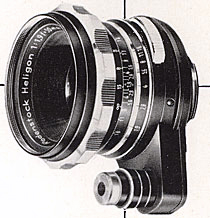
Rodenstock Heligon 50mm/2.8 with mount and trigger for Exakta Varex.
It was also available with 42 mm screwmount for Edixa, Praktica - and Asahi Pentax.
‘Made in Germany’
and ‘Made in Western Germany’ were labels
almost guaranteeing the best available quality.
Kodak’s better cameras,
Retinette and Retina, were produced in Germany with lenses from
Schneider-Kreuznach.
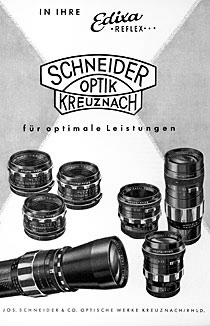
Lenses for Edixa Reflex by Jos. Schneider & Co. Optische Werke Kreuznach/Rheinland.
Names were Xenar and Xenon. Standard and wide angle lenses had automatic aperture step down. On the tele lenses a manual step down was necessary prior to push the shutter release.
German film brands at that time were Adox and the giant Agfa. Agfa was two separate companies, Agfa in Leverkusen and Agfa in Wolfen in East Germany.
|
The Japanse are coming
In the horizon Japanese cameras and lenses were on their way up. However, for several
years the German photo industry, backed up by German photo magazines would only
speak of cheap and bad imitations. From in fact being bad and cheap imitations Japanese manufacturers got hold of their
quality and they started their own product development.
Brands like Canon, Nikon, Asahi
Pentax, Minolta, Konica, Topcon, Miranda etc. were about to find their way to
European and American photo dealers.
Obviously the German photo industry was so convinced about its own superiority that it totally forgot to look east.

The Nikon F launched in 1958 became in no time the camera of professional photographers.
The imitators were speaking German
Not long ago in a German photo magazine
they blamed the Japanse for the collapse of the German photo industry due to
cheap imitations of German
cameras. That is not true. From the second half of the 50's the
imitators didn’t speak Japanese; they were speaking German and without the
Germans themselves to recognize!
The main problem was that the German camera manufacturers had their eyes fixed upon the top brands Leica and
especially Zeiss Ikon and what they did must be right. Leica might have been out of reach but what Zeiss did, they did too, and obviously without the slightest degree of reflection.
The Leitz people on their part might have thought like the rest of the German camera producers that they were beyond any competition.
Leica
Leica was a range finder camera only, extremely expensive and with exchangeable lenses (28-135 mm).

Leica M2. Rangefinder camera. Too late Leitz launched a SLR.
Shorter and longer lenses could be used, but for the extremely good 21 mm an additional finder was needed and from the 180 mm Hector and up to the 400 mm Telyt a device that virtually
changed the Leica from a handy range finder camera to a clumsy and awkward kind
of SLR.
But it was possible and that because Leica had a focal plane shutter – the perfect
match for SLR’s. But why think of SLR-cameras? Hadn't Leica the ultimate and never beaten optical precision
distance meter built in? So management at Leitz Wetzlar seemed convinced
and that was to become their destiny.
At that time Leica was still, along with the twin-lens Rolleiflex, the darling of professional photographers all over the world. Leitz didn't realize in time that more and more professional photographers wanted the versatility of a SLR.
Zeiss
Zeiss Ikon
had a wide assortment of both range finder cameras and SLR’s. The professional
Contax range finder camera had a focal plane shutter like Leica, the others, however, leaf shutters.
Zeiss-Ikon was that much focused on this kind of shutter that the company
took over the two German manufacturers of leaf shutters.
|
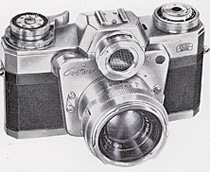
Zeiss Contarex. A Zeiss SLR with a focal plane shutter but too late and too expensive and complicated in manufacturing and with only 250 mm as longest telephoto lens. Most Japanes brands at that time offered at least 600 mm. The shortest focal length was 21 mm.
The Nikon F had lenses from 6 to 2000 mm, a much better light meter system, interchangeable finders and even if expensive sold much cheaper than the Contarex.
Thee leaf shutter
Leaf
shutters had by that time one advantage over focal plane shutters: You could
easily couple aperture and shutter speed.
The draw
back was that they, due to the necessary forward position of the shutter blades were more than limited when it came to interchangeable
lenses.
135 mm was the maximum and the shortest distance to subject would then be four
meters by most brands. Voigtänder eventually succeeded in constructing a 200 mm lens but here closest distance to the subject was about 8 meters!
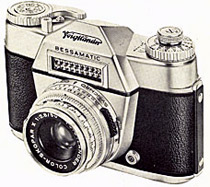
Voigtländer Bessamatic with Syncro-Compur shutter
Lack of consumer knowledge
The
German camera industry didn’t realize that consumers preferred long lenses to convenience; at least not until it was by far too late.
Too long they had their focus on range finder cameras (Leica as their great example) and when eventually they entered the SLR market they blindly followed Zeiss, using leaf shutters.
Thereby they took the wrong and what should become fatal road.
Edixa Reflex, the exception
Gebrüder Wirgin, Wiesbaden would since the mid fifties market a SLR with a focal plane shutter - even if of an old fashioned type, not suited
for coupling with a light meter, but a lot of interchangeable lenses produced by fine independent manufacturers like Schneider Kreuznach and Rodenstock were available. It was called Edixa Reflex.
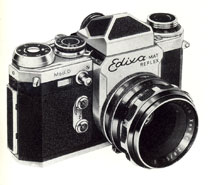
Edixa Reflex. Only West German SLR to have a focal plane shutter in the fifties. But unfortunately the camera had other deficits.
The technical quality of the camera bodies was not very good, however, and Edixa soon was behind the
Japanese competition regarding product development.
Especially the old fashioned version of the focal plane shutter was to become their destiny.
When around the mid sixties Wirgin eventually launched a new SLR it had the Syncro-Compur (Zeiss) leaf shutter!!
|
Eastern Germany
Behind the
iron curtain there were two SLR makes, Exakta Varex and Practika, both of them with
interchangeable lenses and focal plane shutters.
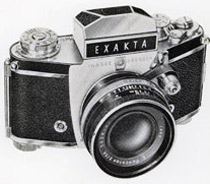
Exakta. Basically it had it all: A long ray of interchangeable lenses, bayonet mount, interchangeable finders and a lot of accessories. But it was awkward to handle. Contrary to all other cameras on the market the film should be wound and the shutter released with the left hand.
Aperture step down was external and on top of that, the camera came from communist East Germany.
Exakta had been launched 1936 as the very first SLR in the world. The communist regime, as it could be expected, didn’t see any
advantages in product development.
Praktica had been the first camera to use what should become the universal 42 mm screw mount. Later it was adapted by Edixa - and Japanese brands like Asahi Pentax. No doubt
Pentax was the superior camera.
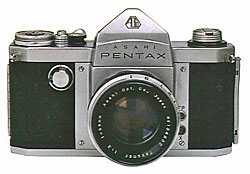
Asahi Pentax. The Japanese alternative to Edixa Reflex and Praktica. Same mount.
What happened to the German brands?
About 1972 Edixa disappeared from the market.
Voigtländer is now owned by Japanese Cosina, marketing some rather nostalgic range finder cameras with focal plane shutters. Lenses also fit on Leica M bodies, by the way.
Rollei has
exploited various product strategies and is today to be seen as a niche product
within professional camera systems. In early 2009, Franke & Heidecke GmbH, Feinmechanik und Optik declared itself insolvent. Their web site (December 2009) is a front page telling that the site is under development.
Schneider-Kreuznach is producing lenses for
Hasselblad and some other manufacturers.
Leica is
still there but has long ago lost its dominating position as the
professional’s camera. Just recently they have made an entry on the digital
camera market.
They are about to market a new digital super format for professionals.
They have some corporation with Japanese Panasonic - lenses and small digital cameras.
Zeiss has long ago given up camera production but has remained within
the lens manufacturing business. For years they have provided Sony with lenses. Recently they have started making their old and excellent prime lenses to fit
Nikons and Canons – no auto focus, however.
Agfa went bankrupt a few years
ago.
No longer on the market are Adox, Regula, Braun München and a lot of other manufacturers.
Learnings
Never underestimate your competitors.
Be aware of consumer needs. Make sure you know what they want, not what you think they want. Fulfil their needs better than competion. Nowadays also at all times be environmentally responsible.
|